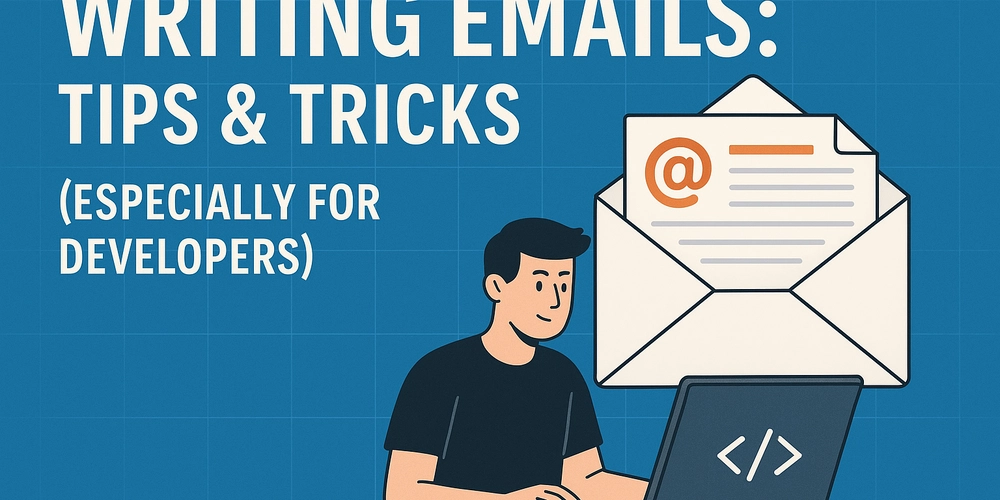You can write clean, efficient code.
But can you write a clean, efficient email?
As developers, we often treat email like a necessary evil — something to send when Jira, Slack, or Teams can’t get the job done. Yet, the truth is: email still matters. It’s how we communicate with stakeholders outside our daily standups, how we document key decisions, and how we request help without waiting for someone to be “green” on chat.
Many emails from developers read like poorly written scripts: unclear purpose, missing context, and way too much (or too little) detail. The result: misunderstandings, delayed responses, and frustrated teammates.
Know Your Goal Before You Write
Just like you wouldn’t start coding without knowing what the function is supposed to do, you shouldn’t start an email without a clear purpose.
Before you hit Compose, ask yourself:
- Am I informing? – Sharing updates, status reports, or decisions.
- Am I requesting? – Asking someone to do something, review something, or provide information.
- Am I persuading? – Convincing stakeholders, proposing solutions, or asking for resources.
If your goal isn’t clear, your reader won’t know how to respond — or might not respond at all.
Pro tip: If you can’t summarize your ask in one sentence, you’re not ready to write the email yet.
Example
❌ Bad:
Hey,
I was thinking about the deployment, but there are a couple of things we need to sort out. Can we talk?
✅ Good:
Hi Alex,
We need to confirm the API migration plan before Friday’s deployment.
Could you review the checklist in the attached doc and approve by EOD Thursday?
Clear goal = faster response.
Subject Lines That Work
Your subject line is the function name of your email — it should tell the recipient exactly what’s inside.
If it’s vague or misleading, your email might get ignored, opened too late, or buried under other priorities.
Keep It Short and Specific
Aim for 5–8 words that capture the essence of your email:
-
Good:
API v2 Deployment – Testing Blocker -
Bad:
Question
Add Context with Prefixes
Prefixes can save time and set expectations:
-
[Action Required]— Something the recipient must do -
[FYI]— No action needed, just information -
[Bug Report]— Problem that needs attention
Bad vs. Good Subject Lines
| ❌ Bad | ✅ Good |
|---|---|
| Update | [Status Update] Sprint 12 – Backend Complete |
| Problem | [Bug Report] Login Fails After Timeout |
| Help | [Action Required] Review PR #452 by Friday |
| Question | [Clarification] API v2 Auth Header Requirements |
Pro tip: If you’re sending a follow-up, add
(Follow-up)or(Reminder)to make it crystal clear.
Structure Your Email Like Good Code
A well-written email is like a well-written function — easy to read, easy to follow, and impossible to misinterpret.
Think of your email in three parts:
- Intro – State the purpose right away.
- Main content – Provide details in short paragraphs or bullet points.
- Conclusion – Restate the key point or action needed.
Example – From Messy to Clean
❌ Messy (Wall of Text)
Hey team, I wanted to let you know that the API changes we discussed are ready, but there are still some open questions about authentication. Also, the tests failed in staging, and I think it’s related to the new timeout settings, but I’m not 100% sure. If you could take a look, that would be great. Oh, and we might need to delay the deployment, but I’m not certain yet.
✅ Clean and Structured
Subject:
[Action Required] API Changes – Authentication Check NeededHi team,
The API changes are ready, but we have two issues to resolve before deployment:
- Authentication: Need confirmation on the new header format.
- Timeouts: Tests failed in staging; likely related to recent timeout changes.
Action: Please review and confirm by Thursday EOD so we can stay on schedule.
Pro tip: Put the most important information first. Don’t make your reader scroll for the point.
Tone: Professional, Clear, and Human
As developers, we often default to just the facts — which is fine for code comments, but in emails, tone matters.
The way you phrase something can make the difference between collaboration and conflict. You don’t need to write like a poet, but you should avoid sounding like a bot.
Keep It Professional
- Avoid slang unless you know the recipient well.
- Skip sarcasm — it’s easy to misinterpret in text.
- Stay respectful, even when reporting problems.
Be Clear
- Use plain language over jargon when the audience is mixed (dev + non-dev).
- If you must use technical terms, make sure the recipient understands them.
Be Human
- Acknowledge effort (“Thanks for reviewing this so quickly”).
- Show empathy when reporting issues (“I know this is last minute, but…”).
Example – Tone Fix
❌ Robotic:
Please review PR #452.
✅ Professional & Human:
Could you review PR #452 by Wednesday?
Thanks — I appreciate your time on this one.Pro tip: Read your email out loud before sending. If it sounds like an error log, rewrite it.
Write for Skimmability
Your recipient might be reading your email between meetings, on their phone, or during a code review.
If they can’t quickly understand your message, they’ll delay reading it — or worse, miss the important parts.
Make It Easy to Scan
- Short paragraphs: 2–3 sentences max.
- Bullet points: Great for lists or multiple updates.
- Bold important info: Deadlines, key numbers, names.
- Headings or separators: Break up longer emails.
Include a TL;DR for Long Messages
If your email is over 5–6 sentences, add a quick summary at the top.
Example – Skimmable Update
TL;DR: Deployment is delayed until Friday due to failed staging tests.
Details:
- Staging environment failed on timeout-related tests.
- Auth header changes need confirmation from the API team.
- New deployment target: Friday 10:00 AM UTC.
Pro tip: Format your email like a README — clear, structured, and easy to follow.
Ask for What You Need Clearly
A surprising number of emails fail because the sender never actually asks for anything.
Or worse, the request is hidden in the middle of a long paragraph.
If you want a response, make the action obvious.
Place the Ask Where It’s Seen
- End the email with a clear, direct request.
- If the action is urgent, highlight it in bold.
Be Specific
- Say what you need.
- Say who needs to do it.
- Say when it’s due.
Example – Action Request
❌ Vague:
Let me know if you can look at this sometime.
✅ Clear:
Could you review PR #452 and leave comments by Thursday EOD?
Pro tip: One email = one main ask. If you have multiple unrelated requests, send separate emails or clearly separate them with bullet points.
Proofread Before You Send
You wouldn’t deploy untested code — don’t send unreviewed emails.
A quick check can save you from confusion, typos, or missing context that forces another round of back-and-forth.
Quick Proofreading Checklist
- Typos & grammar: Run a spell check or re-read slowly.
- Context: Would this make sense to someone not in today’s standup?
- Attachments: Make sure they’re actually attached (we’ve all forgotten).
- Links: Click them to confirm they work and point to the right place.
The 5-Second Re-Read Habit
Before hitting Send, scan your email from the recipient’s perspective:
- Is it clear why you’re sending it?
- Is the action request obvious?
- Is the tone appropriate?
Example – Small Fixes, Big Difference
❌ Before proofreading:
Please check the doc and see if its correct.
✅ After proofreading:
Please check the doc and confirm if it’s correct.
Pro tip: If it’s a high-stakes email, write it, walk away for 10 minutes, then re-read it with fresh eyes.
When NOT to Send an Email
Sometimes the best email is no email at all.
Just like we don’t over-engineer simple scripts, we shouldn’t use email when there’s a faster or more effective way to communicate.
When to Skip Email
- Quick clarifications: Use chat (Slack, Teams) if you need an answer in minutes.
- Complex, sensitive issues: Discuss live to avoid misunderstandings.
- Time-sensitive blockers: A quick call can prevent hours of waiting.
Why It Matters
Email is asynchronous — which is great for non-urgent matters, but dangerous when time is critical. Sending an email when a 2-minute conversation would solve the problem can stall work unnecessarily.
Example
❌ Wrong channel:
Subject: Urgent — Login is down in production
(Sent at 9:03 AM, read at 11:45 AM)
✅ Better channel:
Ping the on-call dev in Slack, then follow up with an email summarizing what happened for documentation.
Pro tip: Use email for what it’s good at — clear, documented communication — not for firefighting.
Bonus Developer-Friendly Tricks
Small habits and tools can make email writing faster, cleaner, and less painful — especially if you send similar types of emails often.
Use Templates for Recurring Emails
- Status updates, bug reports, meeting follow-ups — have a ready-made format so you don’t start from scratch every time.
Keep a “Snippets” File
- Store common phrases or explanations you use often (e.g., deployment steps, API request formats).
- Many editors and email clients support text expansion tools — type
;statusand get your whole status update template.
Format Like a Dev
- When discussing code, wrap it in backticks (
likeThis) or paste a small code block. - Use Markdown-friendly formatting if your email client supports it.
Automate Routine Notifications
- For build success/failures or log reports, automate them instead of sending manual updates.
- Just don’t spam your teammates — keep automation meaningful.
Pro tip: Think of your email workflow as part of your dev toolkit. The less friction, the more consistent and clear your communication will be.
So next time you hit Compose, think of it as a pull request for someone’s attention — make it clean, make it clear, and make it worth merging.
🔖 Stay ahead of the dev curve
I created a Curated RSS Feed Bundle for Web Developers — a hand-picked OPML file of the best dev blogs and websites on the internet.
💡 Just download, import into your favorite RSS reader (like Feedly or NetNewsWire), and enjoy fresh insights every day.
👉 Grab it on Gumroad — stay sharp without the noise.



